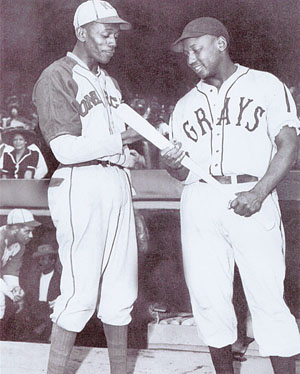Josh Gibson
I wrote the article below for the November edition of the Cuban baseball magazine “Universo Beisbol” .
Hello baseball aficionados. Here is November’s editon of Yankeebiscuitfan’s World. This time a piece about a Negro League legend. Since I read a book about the Negro Leagues, I have been fascinated by him.

Josh Gibson was born on December 21st, 1911 in Buena Vista Georgia. He was the son of a sharecropper. At the age of ten, his parents moved to Pittsburgh to look for work. Their small farm wasn’t profitable at all, so they preferred to move rather than to suffer from poverty in the South. His dad found a job at the Carnegie-Illinois Steel factory.
Josh started to study for a job as an electrician but never finished it. At the age of sixteen, he started to play baseball (third base) at an amateur team that was sponsored by Gimbels department store where Gibson had a job as an elevator operator.
In 1928 Gibson was signed by the Pittsburgh Crawfords, back then still a semi-pro team. With this team and the other semi-pro teams in the Pittsburgh area he had played for, he was famed for his hitting, especially his slugging capacity.
According to the stories, Gibson attended a game between the Homestead Grays and the Kansas City Monarchs in Pittsburgh when their regular catcher Buck Ewing injured his finger while catching Smokey Joe Williams. The two backup catchers didn’t want to step in because they didn’t want to play under the portable lighting system that the Monarchs brought with them. Grays player-manager Judy Johnson looked into the stands and asked Gibson if he wanted to fill the open spot. He did and debuted in the Negro leagues in the middle of a game at July 31, 1930. A year later while barnstorming the US with the Grays, his young wife Helen died in labor, leaving Josh and two newborns behind. The children would be raised by Helen’s parents because Josh was on the road most of the time.

Josh Gibson (r) together with Satchel Paige
In general, Josh went where the money was. He played for the Homestead Grays in the first two seasons of his career. But in 1932 he moved to the cross-town rival Pittsburgh Crawfords. Their owner, Gus Greenlee raided the Homestead Grays and signed all the team’s good players. Gibson played for the Crawfords from 1932 to 1936. Gibson went to play in the Dominican Republic for the Dragones de Ciudad Trujillo. When he returned to the Crawfords to play in 1938, the financial troubled Greenlee sold him to Grays owner Cumberland Posey and the Crawfords went out of business. He helped the Grays to win two consecutive titles in 1938 and 1939. During the winter he headed to Puerto Rico to play winter ball and to earn some extra money. During the 1940 and 1941 season, Gibson played in Mexico for the Azules de Veracruz. Life over there was much more worth living than in the segregated United States. In Mexico, he was a star no matter the colour of his skin and people accepted him as a human being instead of seeing him as a second-grade citizen.
In those days, there were not many regular season games. Before Gus Greenlee founded the Negro National League, teams played only a limited number of games against teams of their own league. Most of the time they were on barnstorming tours because that generated the most money. Gibson’s stats are not quite exact. The stories tell that he hit a total of 800 home runs in his career; a number that is confirmed on his plaque in the baseball hall of fame in Cooperstown New York.
He played against teams of all kinds of levels. He also played against the biggest Major League stars of those days, walloping some very long home runs. The Homestead Grays played half of their home games at Pittsburgh’s Forbes Field and half at Griffth Stadium in Washington DC. Especially Griffith Stadium was a homerun hitters nightmare. But Gibson slammed some home runs like it was the easiest thing to do. Clark Griffith, owner of the Washington Senators wished he had Gibson on his team. But the “rules” of those days did not allow black ballplayers to play in the Majors.
Recently there has been a study after his stats, as far as they are available. Most Negro Leagues didn’t keep stats in a regular way. Despite playing most games vs inferior teams during barnstorming tours, Gibson hit between 150 and 200 home runs in regular Negro League games. Gibson hit two home runs in 56 at bats vs Major League pitchers in off-season games and 44 in 450 at-bats in the Mexican League.
In 1943 Gibson was diagnosed with a brain tumor. He declined the option of surgery because he feared to end up like a vegetable. He lived on with recurring and terrible headaches. Gibson started drinking heavily. Despite his timid personality he started to be loudmouthed. Despite his health issues, he dominated the league in 1943 with a .521 batting average. He was also crowned as the league’s home run king. It has been told that during the final years of his career he spend many days in the hospital. Around game time he was rushed to the stadium only to be brought back after the game was over.
After the 1946 season, Gibson started to get depressed. Earlier in the year, he heard the news that the Dodgers had signed Jackie Robinson to a contract. Josh felt that he was the best player and not Robinson. But Branch Rickey wanted a mentally strong player who could resist the racial abuse. Rickey knew that Gibson would not be able to do so.
Eventually, Gibson died in early 1947 because of a stroke, three months before Jackie Robinson would make his first strides in the Major Leagues. Gibson would soon be forgotten. It would take years before he would get the attention that he deserved. He was enshrined in the baseball hall of fame in 1972 by the Negro Leagues Committee.


Gibson’s gravestone at Allegheny Cemetery. Pittsburgh, PA
Gibson’s legacy is still so great that even nowadays jersey manufacturer Ebbets Field Flannels is selling a Homestead Grays jersey that wears his number.


The U.S. Postal Service issued a 33-cent U.S. commemorative postage stamp which features a painting of Gibson and includes his name.

It is sad that a great player like Gibson never had the chance to show what he was able to because of the discriminatory gentlemen’s agreement called the Colour Barrier.
If you want to read the article in Spanish, click on the picture of the magazine below. It will redirect to the website of 4share. You have to register. After you have done that, you can choose the free download.


